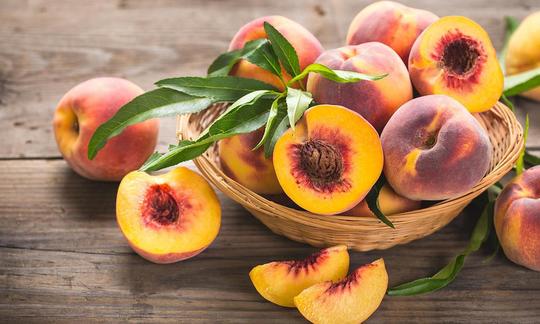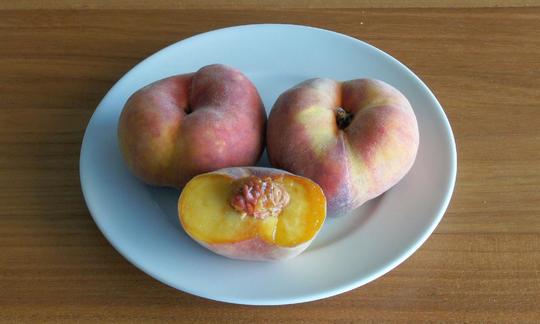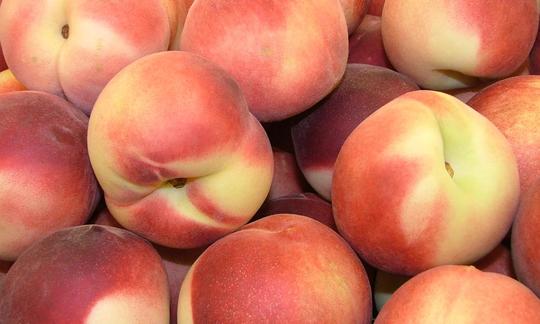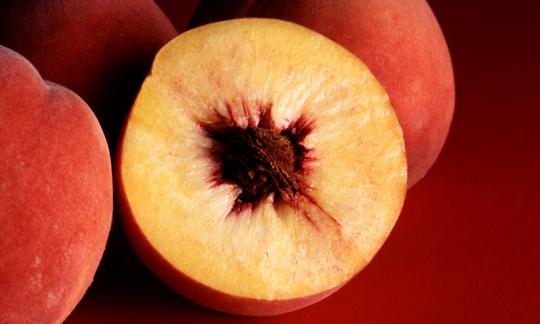Table of contents
Raw peaches ( Prunus persica ) are available in different varieties, including flat peaches and nectarines . Organic peaches are preferable as they are not contaminated with pesticides.
Use in the kitchen:
The peach is usually a round fruit with a diameter of up to 12 cm. The red-yellow skin has a furry down. The flesh is whitish or yellowish in color depending on the variety and encloses a hard, 1.5-2.5 cm large, deeply grooved fruit stone. Depending on the variety, the tender flesh tastes different degrees of sweet.
Peaches taste best when fresh and raw, but they can also be cooked or dried. Peaches have a high water content, which makes them a perfect refreshment. Since the juice can easily spill on you, it is advisable to cut them into bite-sized pieces before eating.
How do you cut a peach? When cutting a peach, you should first carefully cut vertically around the stone. Often, the fruit can then be broken into two pieces by hand, with the stone remaining in one of the two halves. From there, it is easy to remove and the peach can be cut into smaller pieces.
The refreshing aroma with an intense sweetness refines fruit salads or is a great topping for pea muesli . Peaches taste delicious in smoothies and shakes. Cooked, the pureed fruit pulp can be used to make jam, compote or chutneys. Frozen or pureed raw, the fruit pulp is excellent for various desserts (e.g. fruit ice cream, fruit puree or smoothies).
There are various peach products on the market. Dried peaches are sweet dried fruits that can be enjoyed as a snack or in fruit bread. Peach juice is also available, pure or mixed with other fruits. The juice can be used diluted or undiluted to drink or to sweeten tea or dessert. When frozen, it can easily be made into water ice. Peach stones (and apricot stones) are also used to make Persipan, a special form of marzipan that is normally made from almonds. The name is a portmanteau of the Latin 'persicus' peach and 'pan' bread. Persipan tastes sweet and slightly bitter.
Recipe for smoothie with peach
A wonderful refreshment is created from summer fruit if you cut a large, fully ripe peach (organic) into pieces, add a small, ripe banana and about 130 g of well-cleaned, fresh (or frozen) organic raspberries. Mix all the fruits together well to get a thick, almost creamy mixed drink. You can dilute the vegan raw fruit drink with mineral water or drinking water as desired.
Vegan recipe for tomato and peach salad
Ingredients (for 4 people): 3 beef tomatoes, 3 peaches, 1 onion, 50 ml orange juice, 1-2 tbsp almond butter, 1 clove of garlic, 4 tbsp balsamic vinegar, salt andpepper, bunch of fresh basil .
Preparation: Wash the tomatoes and peaches and drain well. Stone the peaches and cut them into bite-sized pieces together with the beef tomato. Peel the onions and dice finely. Add freshly squeezed orange juice. Peel and press the garlic, or chop finely. Mix the almond butter, orange juice and balsamic vinegar in a bowl. Add the garlic and onion and season with salt and pepper. Add the diced tomatoes and peaches to the vinaigrette and mix well. Wash the basil and shake out the water. Pick the basil leaves and mix them into the tomato and peach salad.
Vegan recipes with raw peaches can be found under the note: " Recipes that have the most of this ingredient ".
| Not only vegans or vegetarians should read this: Vegans often eat unhealthily. Avoidable nutritional errors . |
Purchasing - Storage
The peach is a typical summer fruit. The regional peach season in the DA-CH countries lasts from mid-July to mid-August .
Supermarkets and wholesalers such as Coop, Migros, Denner, Volg, Spar, Aldi, Lidl, Rewe, Edeka, Hofer, Billa etc. have various types of peaches on offer, some of which are organic. Peaches are often heavily sprayed and the pesticide residues can only be partially washed off with water. It is therefore worth buying controlled organic and regionally grown fruit that has not been sprayed. You can buy delicious organic peaches in organic supermarkets such as Denn's Biomarkt and Alnatura, and sometimes in wholesalers or at the weekly market.
When buying, you should make sure that the fruit has no damaged areas, otherwise it will quickly rot. Most peaches available in stores are harvested unripe. Half-ripe or ripe peaches are too sensitive to pressure and therefore cannot be transported.
When are peaches ripe? The skin of unripe peaches has not yet changed from green to yellow-red. A light pressure with your finger on the peach reveals its degree of ripeness. Since peaches are climacteric and ripen quickly, you don't have to eat them hard. However, a ripened peach never has the juiciness and sweetness of a fully ripe fruit. You should avoid peaches with shriveled skin, because these specimens are overripe and will rot quickly.
There are often price differences between different types of peach. White-fleshed peaches are often more expensive because they are particularly aromatic and juicy. However, they are also more delicate than yellow-fleshed fruits. Flat peaches (donut peaches) are also increasingly available at major retailers, as is the popular nectarine (smooth peach, naked peach). In some areas near wine-growing regions, you can also buy vineyard peaches (blood peaches).
The availability of peaches varies depending on the size of the store, catchment area, etc. Our recorded food prices for the DA-CH countries can be found above under the ingredient image - and by clicking on them you can see their development at different suppliers.
Storage tips
Peaches ripen at room temperature. If the fruit is already ripe when you buy it, you should eat it or process it within one or two days. Ripe and undamaged fruit can be stored in the fridge for a short time. This will delay the ripening process. But they must not touch each other, otherwise they will quickly rot.
Peaches can be frozen by blanching them, peeling the skin, cutting the fruit into pieces and filling them into suitable containers. You can also make peach puree and freeze it.
Ingredients - Nutritional values - Calories
Peaches are considered healthy fruits with few calories. A medium-sized peach weighing 100 g consists of 87% water and has an energy content of 39 kcal. The flat peach has a similar number of calories. The carbohydrate content (9.5 g/100g) consists almost entirely of sugar (8.4 g/100g). Peaches contain little fat and protein, but valuablefiber (1.5 g/100g). 1
Peaches contain 190 mg/100g of potassium (10% of the daily requirement). Black mulberries (194 mg/100g), grapes (191 mg/100g) and kumquat (186 mg/100g) have similar amounts. Good sources of potassium are herbs, legumes and nuts. Among the fruits, bananas (358 mg), soursops (382 mg) and guavas (417 mg) contain a lot of potassium. 1
Raw peaches contain 6.6 mg of vitamin C per 100 g, around 8% of the daily requirement. Muscadine grapes (6.5 mg/100g) and cherries (7 mg/100g) have comparable amounts of ascorbic acid. Sea buckthorn berries (450 mg/100g) and guava (228 mg/100g) contain particularly high levels of vitamin C. 1
It also contains large amounts of vitamin E. The approximately 0.73 mg per 100 g covers 6% of the daily requirement. Persimmons, black mulberries andraspberries have a similar vitamin E content (both 0.87 mg). The fat-soluble vitamin E is found in larger amounts in nuts such as hazelnuts (15 mg), almonds (26 mg) and sunflower seeds (35 mg). 1
Niacin (ex vitamin B3 ), vitamin K, pantothenic acid (vitamin B5 ) as well as phosphorus and manganese are also present in small amounts. 1
The total ingredients of peach (raw), the coverage of the daily requirement and comparison values with other ingredients can be found in our nutrient tables. In the article Nutrients explained you will get a detailed insight into the topic.
Effects on health
Are peaches (flat peaches) healthy? How healthy are peaches? Peaches contain important vitamins, minerals and trace elements. Potassium is plentiful (see above). This is important for bone metabolism, helps regulate blood pressure and has a positive effect on the cardiovascular system. 15 The vitamin C (ascorbic acid) contained in peaches strengthens the immune system and acts as a radical scavenger (antioxidant). 16
Secondary plant substances
Many of the health effects of peaches (raw) can be attributed to the secondary plant substances they contain. Our article on secondary plant substances provides an overview of the classification of substance groups, their occurrence in foods and possible effects on humans. Peaches contain the following secondary plant substances:
- Isoprenoids: Carotenoids 15,18
- Polyphenols: Phenolic acids: hydroxycinnamic acid (chlorogenic acid, neochlorogenic acid); flavonoids: flavonols (quercetin, kaempferol, rutin), flavanols (catechin), proanthocyanidins 15,17,18
The content varies depending on the peach variety, rootstock, climate, agronomic practices and ripeness at harvest. 15 The nutrients are contained in the pulp and the peel, with the peel often having a higher content than the pulp. 15
The specific phenolic acid components chlorogenic acid and neochlorogenic acid, which are found in both peaches and plums, have, among other things, an anti-cancer effect against breast cancer cells. Unripe fruits have a slightly higher content of secondary plant substances than ripe peaches. 15 Phenols, carotenoids and vitamin C have an antioxidant effect. 17
The anthocyanin content is higher in reddish peach varieties than in yellow-fleshed varieties. 19 Blue berries such asblueberries, aronia berries and black currants are particularly rich in anthocyanins. The carotenoid content in yellow-fleshed peaches and nectarines is around 71-210 µg/100 g, while white-fleshed peaches only have 7-20 µg/100 g. Storing the fruit in a cool place leads to a slight reduction in the carotenoid content. 18 The polyphenol content is around 67.9 mg/100 g for yellow-fleshed peaches, 40.9 mg/100g for yellow-fleshed nectarines and 49.7 mg/100g for white-fleshed nectarines. Cold storage leads to an increase in the polyphenol content. 18
Peaches also contain anti-cholinesterase agents. These lead to an increase in acetylcholine levels in brain tissue, which is a useful tool in the treatment of Alzheimer's disease. Current treatment for Alzheimer's disease involves inhibiting AChE and BChE activity in the brain, which leads to an increase in acetylcholine (ACh) levels in the brain. The quercetin and kaempferol contained in peaches are efficient AChE and BChE inhibitors. The effect of the rutin contained in peaches is weaker, but detectable. Based on the study results and the neuroprotective role of quercetin and kaempferol, peaches are considered a promising source of bioactive compounds for the prevention and treatment of Alzheimer's disease. 17
Dangers - Intolerances - Side effects
Allergic reactions to peaches (nectarines) are more common than you might think. A European study from 2014 to evaluate allergen-specific sensitization rates in fruit showed that peaches were the most common trigger of sensitization. 4 People with allergies are sometimes advised to peel or cook peaches so that the affected people can eat them. 3
However, peaches contain different allergens, which are found in both the peel and the flesh of the fruit. Not all of them can be destroyed by heat. 4
People with a birch pollen allergy can develop a peach allergy due to the similarity of certain proteins. This phenomenon occurs mainly in northern Europe. Symptoms generally appear within 5–15 minutes after eating raw peach and include local reactions in the mouth and throat with itching and inflammation (so-called oral allergy syndrome, OAS). The allergen responsible for this is not heat stable, which is why patients can eat cooked peach. 5
In Mediterranean countries (Italy, Spain), people often have a peach allergy due to another allergen. Symptoms are more severe and include urticaria (skin rash), abdominal pain and vomiting in addition to oral allergy syndrome. These people tend to react more frequently and more severely when they eat the peaches with the skin. Cross-allergies to apples, apricots, plums, cherries, nuts (such as hazelnuts and walnuts ) and peanuts are common. The allergen responsible is heat stable, which is why affected people cannot eat cooked peaches either. 5
Peach seeds (peach kernels) contain up to 6.8 mg/g amygdalin, which is more than twice as much as in apricot kernels. This cyanogenic glycoside is converted into poisonous hydrogen cyanide during chewing and digestion. Eating peach kernels (in large quantities) is therefore not recommended. 20
Conventionally grown peaches are often contaminated with pesticides that cannot always be completely removed even by thorough washing. Conventionally grown peaches are often contaminated with pesticides that cannot always be completely removed even by thorough washing. A 2019 study shows that all conventionally grown peaches and nectarines contained pesticide residues. Only the two organic fruits were free of pesticides. 6 It is therefore advisable to buy organic peaches.
Ecological footprint - animal welfare
The ecological footprint of peaches depends on various aspects, including the cultivation method (conventional/organic), seasonality, the country of origin and the corresponding transport and, if applicable, the packaging. A study from Germany gives a CO 2 footprint of 0.2 kg CO 2 eq/kg. 7 According to the Danish climate database Concito, this is 0.66 kg CO 2 eq/kg. 8 The same applies to peach consumption in Switzerland, where they are primarily imported from Spain and Italy. 9
Peach cultivation in Europe takes place mainly in Spain and Italy. 2 Both countries require artificial irrigation to produce economically relevant quantities of peaches. The average water consumption per 1 kg of peaches worldwide is 922 litres of water. 10
For detailed explanations of various sustainability indicators (such as ecological footprint, CO2 footprint, water footprint), see our article: What does the ecological footprint mean?
Worldwide occurrence - cultivation
Where do peaches come from? The peach tree originally comes from China, where it has been cultivated since around 3000 BC (domestication center). In the 2nd and 1st centuries BC, peach trees were introduced to Iran and later peaches were cultivated throughout the Mediterranean region (Italy, France). Starting with European varieties, the Spanish introduced peaches to Central America in the 16th century, from where peach trees spread northwards. A second introduction took place in the mid-19th century from China. 12
The domestication and breeding of peaches has led to an increase in fruit size and taste (e.g. sugar and acid content). The history of peach trees' spread is also reflected in their genetic material. Today's varieties in North America and Europe are genetically more closely related than the varieties bred later and at the same time in Asia. 11
Peaches are a popular fruit. Around 26.35 million tonnes were produced worldwide in 2022. The main growing area is China with 16.8 million tonnes of peaches (2022). Other major producers are Spain (2021: 1.19 million tonnes), Italy (2021: 996,860 tonnes, 2022: 1.2 million tonnes) and Turkey (2022: 1 million tonnes). 2
Found in the wild
The peach ( Prunus persica ) is a cultivated fruit tree and rarely grows wild. The name 'wild peach' usually refers to the flat peach (plate peach). Although the name suggests that these fruits grow wild, they are grown in orchards.
Wild relatives such as Prunus davidiana, Prunus ferganensis, Prunus kansuensis and Prunus mira occur in China. 12
Possible confusion
Nectarines are a type of peach. They are also called smooth peaches or naked peaches because they have a smooth skin surface. Yellow and white-fleshed peaches, on the other hand, have a slightly furry skin.
Cultivation - Harvest
Peach trees can be grown in your own garden. They need a sunny, warm location and enough space. Loamy, nutrient-rich soil with a high humus content is ideal for peaches. Lighter soils can be improved with compost. In larger garden centers, you can buy peach varieties of different sizes. Before buying, find out about the specific location conditions and how tall the peach tree can grow. Peaches are best planted in autumn so that they can take root well by winter. Alternatively, you can plant them in spring. During fruit formation, the peach tree needs a constant supply of water. Regular pruning promotes fruit formation. 13
The peach tree is one of the most demanding fruit trees. If there are excess fruit on the branches during the growth phase, these must be thinned out. This removes small fruits that have no market potential, leaving more nutrients for the remaining fruits. The peach tree bears its fruit on one-year-old wood, i.e. on the shoots that grew the previous year. Each long shoot only bears fruit once. By the third year, it no longer forms flower buds and has hardly any leaves. For this reason, it is essential to prune the branches after the fruit harvest or in spring. Better yields and good fruit quality are achieved when the peach trees are grown as espaliers with fan-shaped side shoots. 14
Further information
The peach tree ( Prunus persica L. Batsch) is one of the most important species of the genus Prunus and belongs to the rose family (Rosaceae). The genus Prunus includes apricots ( P. armeniaca ), plums ( P. domestica ), blackthorn ( P. spinosa ), sour cherries ( P. cerasus ), cherries ( P. avium ) and almonds ( P. dulcis ).
There are numerous types and varieties of peaches, the most popular are:
- Flat peach or plate peach ( Prunus persica var. platycarpa ): The fruit has a flattened shape. The flesh tastes very sweet and aromatic. The flat peach is also called donut peach, wild peach (causes consumer confusion), Adelsberg peach, mountain peach, Saturn peach and, confusingly, vineyard peach.
- Nectarine : The nectarine ( Prunus persica var. nectarina ) is a mutation of the peach with a smooth skin. It is slightly smaller than the round peach, but similar in color. The flesh is white, yellowish or reddish depending on the variety and tastes very sweet.
- Nectavigne: The Nectavigne is a cross between the nectarine and the 'Lyonais vineyard peach'. This fruit has only been available on the market since 2004.
- Vineyard peach or vineyard peach: It has a dark red, very firm flesh that is less sweet.
Alternative names
Common names for peaches are Plüschprumm and Bügnole. The stone fruit is also known under different varieties, e.g. nectarine, nectavigne, flat peach, donut peach, vineyard peach or vineyard peach.
In English the peach is called peach, the flat peach is called flat peach.
Bibliography - 20 Sources
| 1. | USDA United States Department of Agriculture. |
| 2. | FAOSTAT Food and Agriculture Organizsation of the United Nations. Peaches and nectarines (production Quantity 2021, 2022). |
| 3. | Pamplona-Roger J. Heilkräfte der Nahrung. Zürich: Advent-Verlag; 2006. |
| 4. | Matricardi PM, Kleine-Tebbe J et al. EAACI Molecular Allergology User's Guide. Pediatr Allergy Immunol. 2016;27(S23):1-250. |
| 5. | University Manchester, InformAll: Communicationg about Food Allergies. Allergy information for: Peach (Prunus persica). |
| 6. | LAVES Niedersächsisches Landesamt für Verbraucherschutz und Lebensmittelsicherheit. Pflanzenschutzmittelrückstände in Pfirsichen und Nektarinen 2019. |
| 7. | Reinhardt G, Gärtner S, Wagner T. Ökologische Fussabdrücke von Lebensmitteln und Gerichten in Deutschland. Institut für Energie - und Umweltforschung Heidelberg. 2020. |
| 8. | CONCITO The Big Climate Database. Version 1.1. Peach. 2024. |
| 9. | Zhyiyenbek A, Beretta C, Stoessel F, Hellweg S. Ökobilanzierung Früchte- und Gemüseproduktion - eine Entscheidungsunterstützung für ökologisches Einkaufen. ETH Zürich. 2016. |
| 10. | Mekonnen MM, Hoekstra AY. The green, blue and grey water footprint of crops and derived crop products. Hydrol. Earth Syst. Sci. 2011; 15: 1577-1600. |
| 11. | Li Y, Cao K et al. Genomic analyses of an extensive collection of wild and cultivated accessions provide new insights into peach breeding history. Genome Biol. 2019;20(1):36. |
| 12. | Layne DR, Bassi D (Ed.) The Peach. Botany, production and uses. CABI 2008. |
| 13. | Plantura.garden Pfirsichbaum pflanzen: Anleitung & Tipps vom Profi. |
| 14. | Damerow L., Blanke M., Schulze-Lammers P. Mechanische Fruchtbehandlungsregulierung im Kernobstbau. Landwirtschaftliche Fakultät der Universität Bonn, Schriftenreihe des Lehr- und Forschungsschwerpunktes USL. 2007;143. |
| 15. | Dabbou S, Maatallah S et al. Carotenoids, Phenolic Profile, Mineral Content and Antioxidant Properties in Flesh and Peel of Prunus persica Fruits during Two Maturation Stages. Plant Foods Hum Nutr. 2017;72(1):103-110 |
| 16. | Biesalski H K, Grimm P. Taschenatlas der Ernährung. Stuttgart: Georg Thieme Verlag; 2015, 6. Auflage. |
| 17. | Szwajgier D, Borowiec K, Zapp J. Activity-guided isolation of cholinesterase inhibitors quercetin, rutin and kaempferol from Prunus persica fruit. Z Naturforsch C. 2020;75(3-4):87-96 |
| 18. | Di Vaio, C., Graziani, G., Marra, L. et al. Antioxidant capacities, carotenoids and polyphenols evaluation of fresh and refrigerated peach and nectarine cultivars from Italy. Eur Food Res Technol. 2008;227:1225–1231 |
| 19. | Reig G, Iglesias I, Gatius F, Alegre S. Antioxidant capacity, quality, and anthocyanin and nutrient contents of several peach cultivars [Prunus persica (L.) Batsch] grown in Spain. J Agric Food Chem. 2013;61(26):6344-6357. |
| 20. | Bolarinwa IF, Orfila C, Morgan MRA. Amygdalin content of seeds, kernels and food products commercially-available in the UK. Food Chemistry. 2014;152:133–139. |














Comments